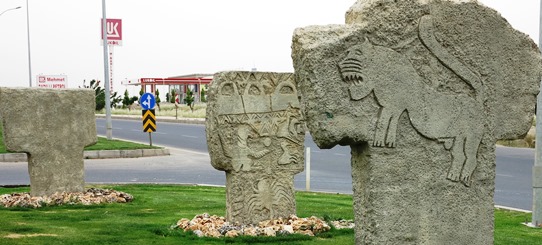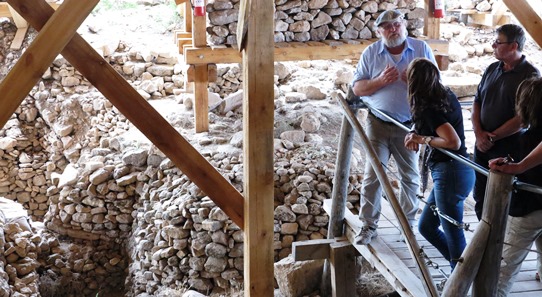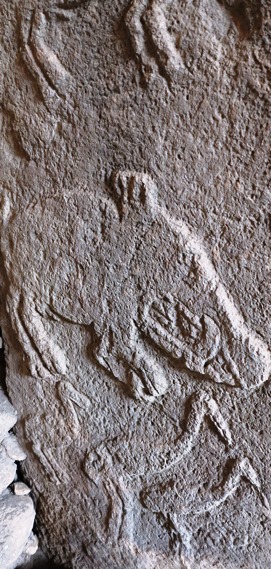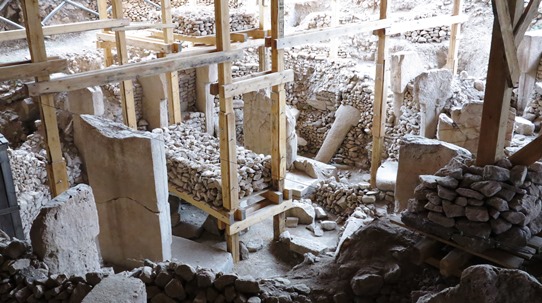Göbekli Tepe – a really ancient Turkish site
Friday, 30 May 2014I’m on the board of GHF – Global Heritage Fund – and I’ve been travelling around Turkey looking at their current Turkish site (Göbekli Tepe), a previous site (Çatalhöyük) and assorted other sites that GHF are interested in, might be interested in or were simply worth having a look at. What any visitor to Turkey quickly discovers is the country has an amazing assortment of ancient sites, well Göbekli Tepe is probably the oldest.
 ▲ No, this is not Göbekli Tepe, as you drive to the site from the nearest big town (and airport) Şanliurfa (also known as Urfa) you pass this roundabout with a little sampler of what you’ll find at the site.
▲ No, this is not Göbekli Tepe, as you drive to the site from the nearest big town (and airport) Şanliurfa (also known as Urfa) you pass this roundabout with a little sampler of what you’ll find at the site.
 ▲ German archaeologist Klaus Schmidt discovered the site at Göbekli Tepe – Potbelly Hill – in the mid’1990s and he’s been working on it ever since. Here he is at the site talking with my wife Maureen and other GHF visitors.
▲ German archaeologist Klaus Schmidt discovered the site at Göbekli Tepe – Potbelly Hill – in the mid’1990s and he’s been working on it ever since. Here he is at the site talking with my wife Maureen and other GHF visitors.
 ◄ It’s the extraordinary reliefs on the Göbekli Tepe stones which make the site so interesting. The site is thought to date from around 9500 BC, which makes it more than 6000 years older than Stonehenge. Like Stonehenge it’s a circle of upright stones, in fact it’s a number of circles with more waiting to be unearthed. But unlike Stonehenge they’re not just mute slabs, they’re decorated with beautifully carved reliefs of wild animals. They’re carved with figures of birds, snakes, scorpions, hyaenas, wild boars, vultures
◄ It’s the extraordinary reliefs on the Göbekli Tepe stones which make the site so interesting. The site is thought to date from around 9500 BC, which makes it more than 6000 years older than Stonehenge. Like Stonehenge it’s a circle of upright stones, in fact it’s a number of circles with more waiting to be unearthed. But unlike Stonehenge they’re not just mute slabs, they’re decorated with beautifully carved reliefs of wild animals. They’re carved with figures of birds, snakes, scorpions, hyaenas, wild boars, vultures
The story of Göbekli Tepe is still a mystery. It’s thought the stones were buried soon after they were carved and have remained underground ever since. They have remarkably little foundation, as if they were never intended to stand up by themselves. Their extraordinary age has recast our ideas of human history. It’s thought to have religious significance, but the construction of a complex sites like this one was considered only to have been possible after mankind moved on from the hunter-gather phase of human development to settled agriculture.
National Geographic featured Göbekli Tepe in its June 2011 edition and you can also find out more about the site on GHF’s website.
 ▲ The site is still being excavated and at the moment visitor facilities are very limited and the principal excavation is covered by an ugly roof. In the next couple of years a much more aesthetically please roof and viewer platform will be constructed.
▲ The site is still being excavated and at the moment visitor facilities are very limited and the principal excavation is covered by an ugly roof. In the next couple of years a much more aesthetically please roof and viewer platform will be constructed.






